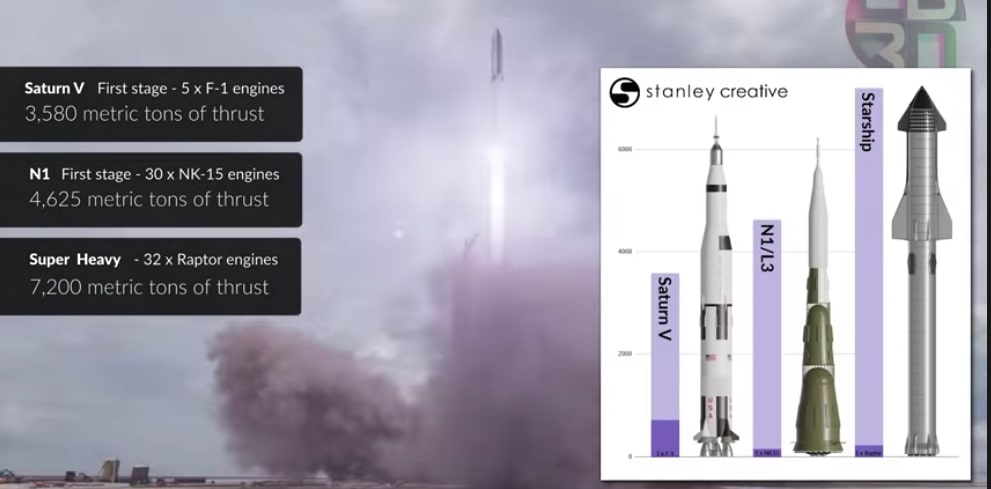Starship vs Saturn v Thrust

In the realm of space exploration, the battle for supremacy often comes down to the fundamental force that propels us beyond Earth’s atmosphere: thrust. In this clash of titans, we pit two giants against each other: SpaceX’s Starship and NASA’s historic Saturn V rocket. Both represent pinnacle achievements in engineering and innovation, but how do they stack up when it comes to thrust?
The Legacy of Saturn V
First, let’s pay homage to the venerable Saturn V. Developed by NASA in the 1960s, the Saturn V remains a symbol of human ingenuity and ambition. Standing at a towering 363 feet tall, it propelled the Apollo missions, including the historic Apollo 11 moon landing. Its five F-1 engines generated a combined thrust of 7.5 million pounds-force (lbf), making it the most powerful rocket ever flown.
The sheer magnitude of the Saturn V’s thrust was awe-inspiring. Each F-1 engine produced over 1.5 million lbf of thrust at liftoff, roaring to life with the force of a small nuclear explosion. The thunderous spectacle of its launch captivated the world and propelled humanity farther into space than ever before.
Enter the Starship
Fast forward to the 21st century, where SpaceX, led by visionary entrepreneur Elon Musk, seeks to revolutionize space travel with its Starship spacecraft. Designed for missions to the Moon, Mars, and beyond, Starship represents a paradigm shift in rocket technology. At a towering height of 394 feet, it surpasses even the Saturn V in size and ambition.
The heart of the Starship’s propulsion system lies in its Raptor engines. Powered by liquid methane and liquid oxygen, these engines boast unparalleled efficiency and versatility. In its current configuration, Starship is expected to feature six sea-level Raptors and two vacuum-optimized Raptors, providing a combined thrust of over 16 million lbf.
Thrust Comparison
Now, let’s delve into the numbers and compare the thrust of these two behemoths side by side. At first glance, it’s evident that Starship holds a significant advantage over the Saturn V in terms of raw thrust. With its 16 million lbf of thrust, Starship outmatches the Saturn V’s 7.5 million lbf by more than double.
However, sheer thrust alone doesn’t tell the whole story. The Saturn V, despite its lower thrust, achieved remarkable feats of space exploration, including landing astronauts on the Moon. Its meticulous engineering and reliability set the gold standard for spaceflight during the Apollo era.
In contrast, Starship aims to push the boundaries of what’s possible in space travel. With its unprecedented thrust capabilities, it promises to make interplanetary colonization a reality. Elon Musk envisions a future where Starships ferry hundreds of passengers to destinations across the solar system, heralding a new era of space exploration and settlement.
Implications for the Future
The comparison between Starship and the Saturn V highlights the evolution of rocket technology over the decades. From the brute force of the F-1 engines to the cutting-edge efficiency of the Raptor, we’ve witnessed a remarkable progression in propulsion systems.
Looking ahead, Starship’s superior thrust capacity opens up a world of possibilities for humanity’s expansion into space. Whether it’s establishing a sustainable presence on Mars or mining asteroids for precious resources, Starship holds the key to unlocking the next chapter in our cosmic journey.
However, challenges lie ahead. SpaceX faces formidable technical, logistical, and regulatory hurdles as it seeks to realize the full potential of Starship. From refining its launch and landing capabilities to ensuring the safety of its passengers, the road to interplanetary travel is fraught with obstacles.
Conclusion
In the ultimate showdown of thrust, Starship emerges as the clear victor, boasting unparalleled power and potential. However, the legacy of the Saturn V serves as a reminder of the remarkable achievements of the past and the enduring spirit of exploration that propels us ever onward.
As we stand on the brink of a new era in space exploration, fueled by the boundless ambition of visionaries like Elon Musk, one thing is certain: the journey ahead will be as awe-inspiring as it is challenging. Whether we’re charting a course for the Moon, Mars, or beyond, the quest for knowledge and discovery will continue to drive us forward, one rocket launch at a time.





